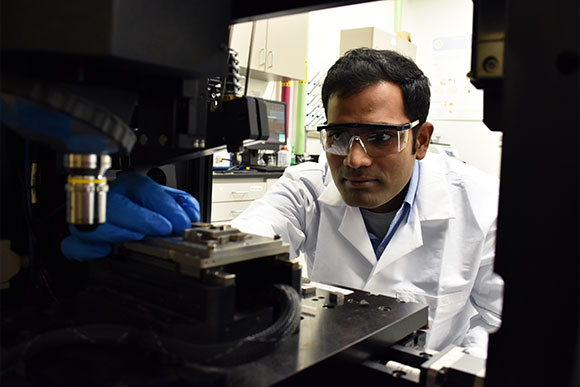
Corrosion and wear are very common – they can happen to any material exposed to an environment. But, what if materials could be tested at the atomic level to determine exactly how and why they break down and then be improved to create ultra-high performance alloys? Researchers at the University of North Texas have done just that – and are designing next generation alloys that could be used in bio-implants or even outer space. Their study was recently published in Scientific Reports.
“We characterized how materials degrade under extreme conditions using a combination of characterization techniques that have never been brought together before,” said Aditya Ayyagari, a recent doctoral graduate with the College of Engineering’s Materials Science and Engineering Department, who is the lead author on the study. “We have measured the wear and corrosion behavior at the microstructural length-scales and presented a comprehensive understanding from different viewpoints.”
The material tested was a complex alloy composed of six different elements and a unique microstructure with crystalline phases in a glassy matrix. The alloy was tested simultaneously for bulk wear and bulk corrosion resistance. Their next step is what makes this research so unique.
“The next level of characterization is where we go beyond the state-of-the-art. It’s called phase-wise characterization,” Ayyagari said. “We actually can understand how components inside the alloy respond. We used a combination of scanning kelvin probe, scanning vibrating electrode technique and Pico-indentation to map the phase-specific properties. Some of these novel, in-situ tests were performed by Vahid Hasannaeimi, a graduate student in the Materials Science and Engineering Department and second author on the paper.”
UNT is one of very few universities equipped for this type of testing all in one place.
“We take the sample, polish it so you see the different phases, put it in a microscope and zoom in so you can see all of them,” said Ayyagari. “You can then use a probe on individual phases to see the wear and corrosion properties. The microscope has a vacuum inside so you have an environment just like you have in space. It is very representative of how this material will behave out there.”
Their testing was partly supported by a National Science Foundation grant earned by Sundeep Mukherjee, associate professor of materials science and engineering and corresponding author on the paper who supervised the project. Their alloys are expected to have major implications for everything from space travel to the future of medical devices.
“This material has a great combination of strength and ductility – the amount a solid material stretches under stress,” Mukherjee said. “Our hope is that once we present these results on phase-specific friction and electrochemical behavior, the applications for it are going to explode.”